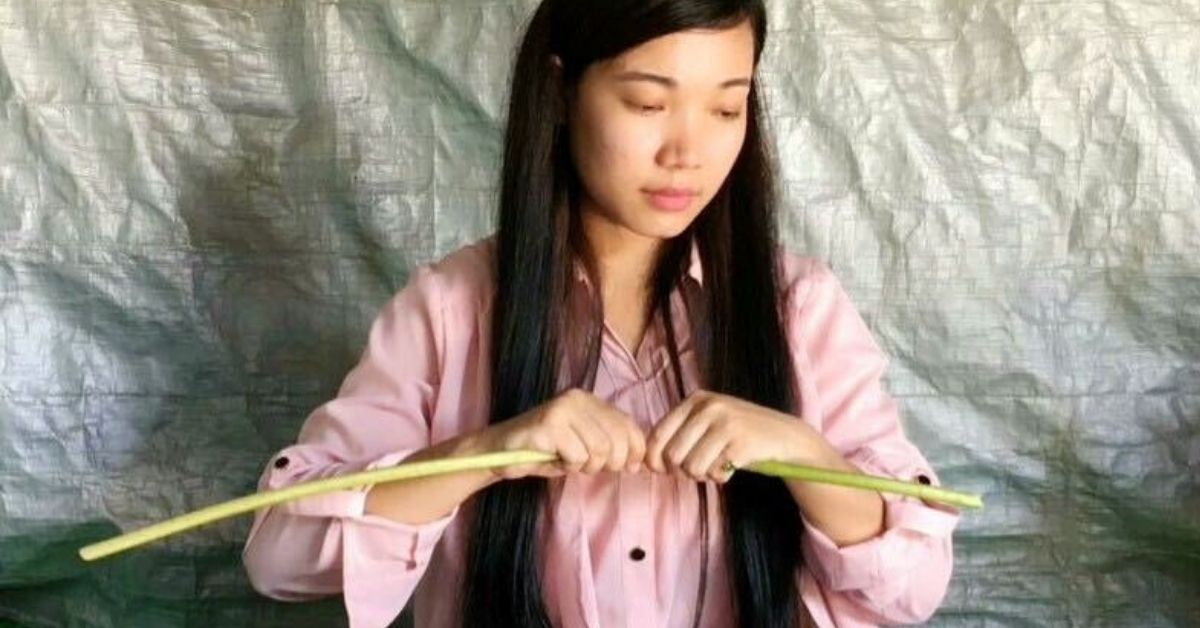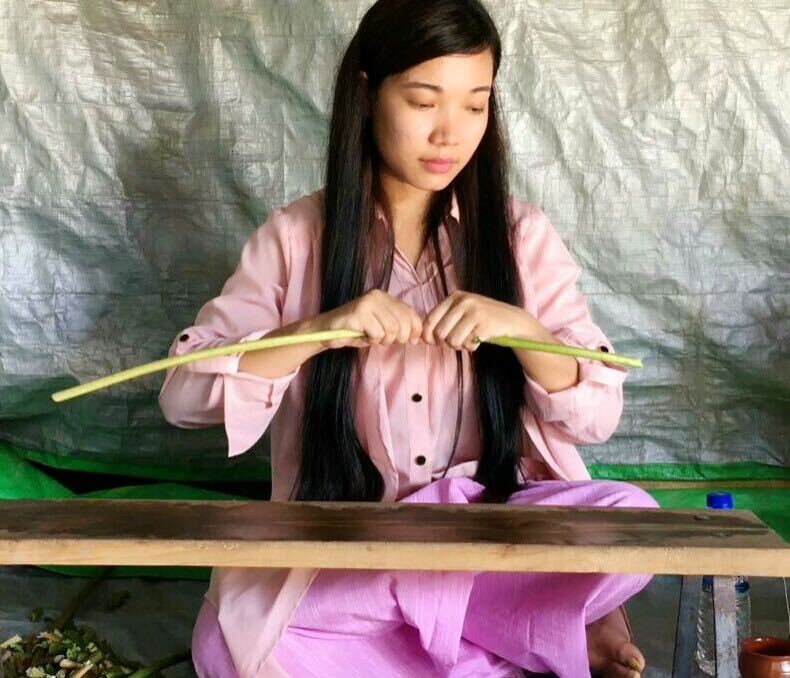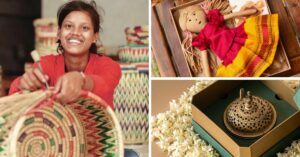Manipur Woman Masters Rare Skill of Extracting Lotus Fibre to Weave Unique Scarves
Referring to videos and articles, 27-year-old Bijiyashanti Tongbram learnt to extract thread from lotus stems. After mastering the technique, she started her own enterprise named ‘Sanajing Sana Thambal’ and decided to teach other women in her village.

Bijiyashanti Tongbram (27), lives in a small village named Thanga Tongbram located in the Bishnupur district of Manipur. A few kilometres from her home is Loktak lake, which is the largest freshwater lake in the Northeast region. This lake is famous for its numerous small islands known as phumdis and the thousands of lotuses blooming in it.
In this region, the lotuses are used as offerings to the gods and also for decorative purposes, but Bijiyashanti has learnt the technique of extracting fibre that is soft as silk from the lotuses’ stems and making thread from it. These threads can be used to knit scarves, stitch ties, and make masks. There are only a few places in the world where this kind of work is done – in Myanmar and in Cambodia.
Since learning the technique to extract the fibre and spin the thread, Bijiyashanti has opened her own enterprise named ‘Sanajing Sana Thambal’ and decided to teach this method to other women in her village.
What inspired her?
In 2014, after completing her Honours degree in Botany from GP Women’s College, Imphal, Bijiyashanti was wondering about what she could do. She could not find a job that she was passionate about and spent the following years trying to come up with a business plan where she could earn and provide employment to others.
In 2018, she attended a programme on ‘How to become an entrepreneur’ at the Ministry of Micro, Small and Medium Enterprises (MSME Centre) in Manipur.
“It was during this 10-day course that I learnt about how to set up a business, and the process of marketing. Once I finished the course I thought about what I was passionate about and I realised that it was lotus flowers because they grow widely in my area. I have always been fascinated with their medicinal properties and started to research on the internet about what I can do with lotuses. That is when I stumbled upon three interesting ideas. One was to make tea using the lotus flowers, the other was to start a lotus garden of my own with varieties from across the world, and finally to extract thread from the stems and make clothes,” says Bijiyashanti, adding that she started with the last option as it seemed most challenging.
She spent the next few months watching videos online and reading about the method of collecting the lotus stems, cleaning them, and extracting fibre.

The process of extracting fibre
The lotuses are usually collected from the lake by the locals to sell at temples and flower markets. But before they are taken to the market the stems are cut and a significant portion of the stems just thrown away.
“I started gathering some of these stems that are thrown away. They have to be soaked in water for three days. This helps the stems produce a sticky substance inside which is the fibre,” says Bijiyashanti.
To extract the fibre, the stem is broken a few inches from one end and split open. Bijiyashanti says that when you split the stem, the gum-like fibre is produced. This is then spread onto a wooden table that is wet and rolled by hand to form one strand of thread usually 40cm long.
She says that initially, it was very challenging to roll the fibre because it is so fine. But slowly, with practice, she got better at it. The thread is allowed to dry under the sun for a few days. Then, it can be used to make fabrics, either on a spinning wheel or loom.
“It is a time-consuming process. I used a thousand stems or more, and it took me over one month to produce enough thread to make one scarf. The spun thread is made into scarves by weaving on a traditional loom and the ties are knitted by hand,” explains Bijiyashanti. For colour, Bijiyashanti added organic dyes.
Providing employment
To start producing garments at a faster pace, she thought about teaching the method to other women in her area, and employing the local community.
“In 2019, when I spread the word around my village, seven women joined me and I taught them how to extract the fibre and do the weaving. Then, the word spread to other nearby villages and a total of 15 women were trained. Their ages range from 22 to 50. By January 2020, I trained 40 people and 20 of them continue to make the thread. 7 of them work from my home-unit and the others have their wooden tables and spinning wheels to extract the fibre. I buy back the fibre from them and stitch neckties, scarves and also plan to make face masks. To make the garments we use a traditional bamboo-based loom.”

Ayingbi is a 50-year-old weaver who joined Bijiyashanti’s enterprise in 2019. She says that this time-consuming handicraft has kept her occupied throughout the lockdown.
“Initially, I did not know that thread can be extracted from lotus stems but now I have been doing it for one year. I have a wooden table and spinning wheel in my home so I can extract fibre and spin the thread. The finished product is as good as silk, and it can be woven using a traditional loom because the thread is very delicate,” she says.
Bijiyashanti hopes to soon open an online store with the products she is now beginning to make and sell, and even export her products by February 2021.

Similar Story

Buying Gifts for Festive Season? Shop From These 8 Places to Help India’s Incredible Artisans
This Diwali and Christmas, choose artisanal brands for your gifts and support the communities behind these crafts. From kitchenware by P-Tal to dolls by Guddee, explore eight brands with their diverse handcrafted products.
Read more >
If you found our stories insightful, informative, or even just enjoyable, we invite you to consider making a voluntary payment to support the work we do at The Better India. Your contribution helps us continue producing quality content that educates, inspires, and drives positive change.
Choose one of the payment options below for your contribution-
By paying for the stories you value, you directly contribute to sustaining our efforts focused on making a difference in the world. Together, let's ensure that impactful stories continue to be told and shared, enriching lives and communities alike.
Thank you for your support. Here are some frequently asked questions you might find helpful to know why you are contributing?


This story made me
-
97
-
121
-
89
-
167












